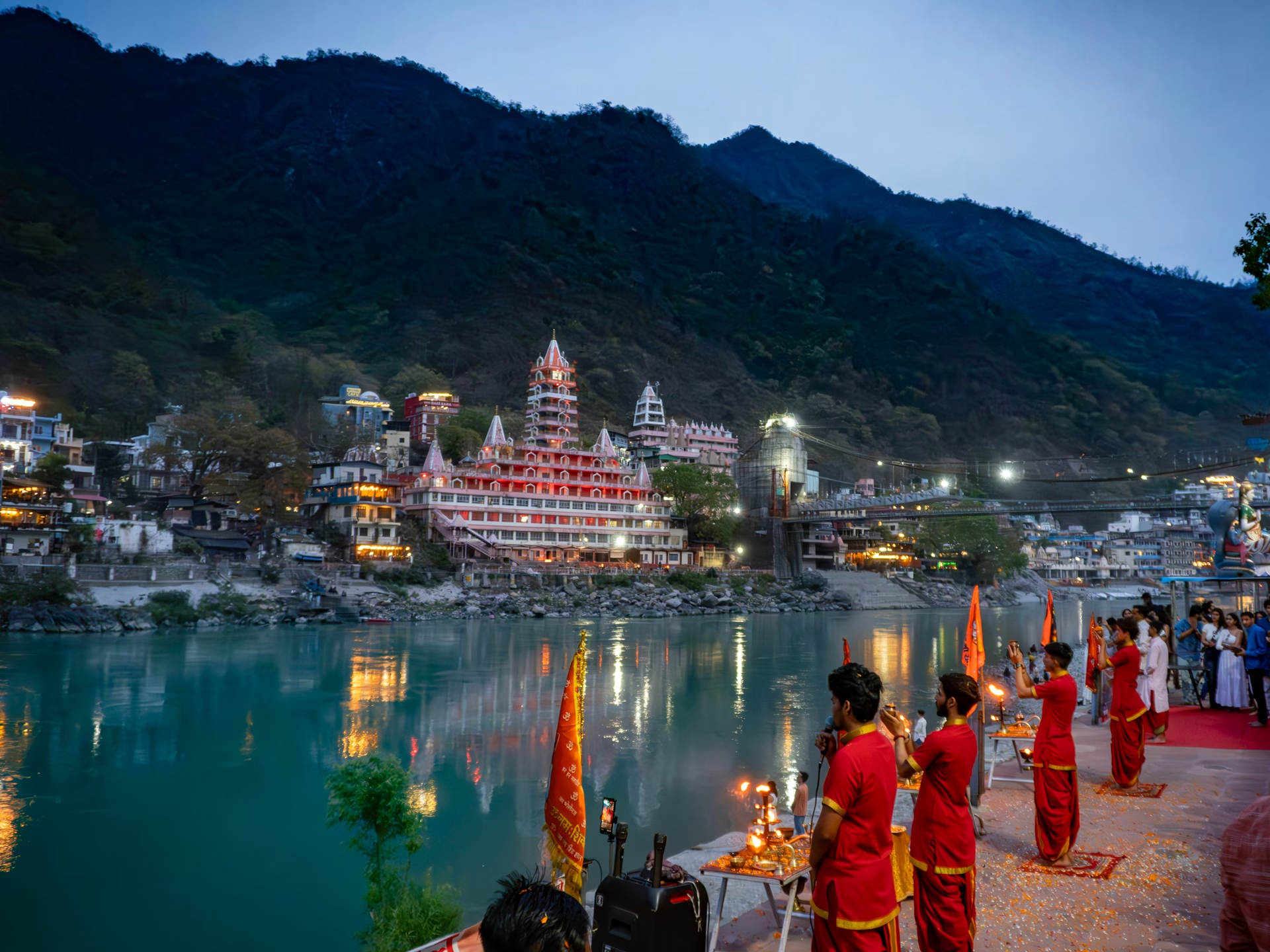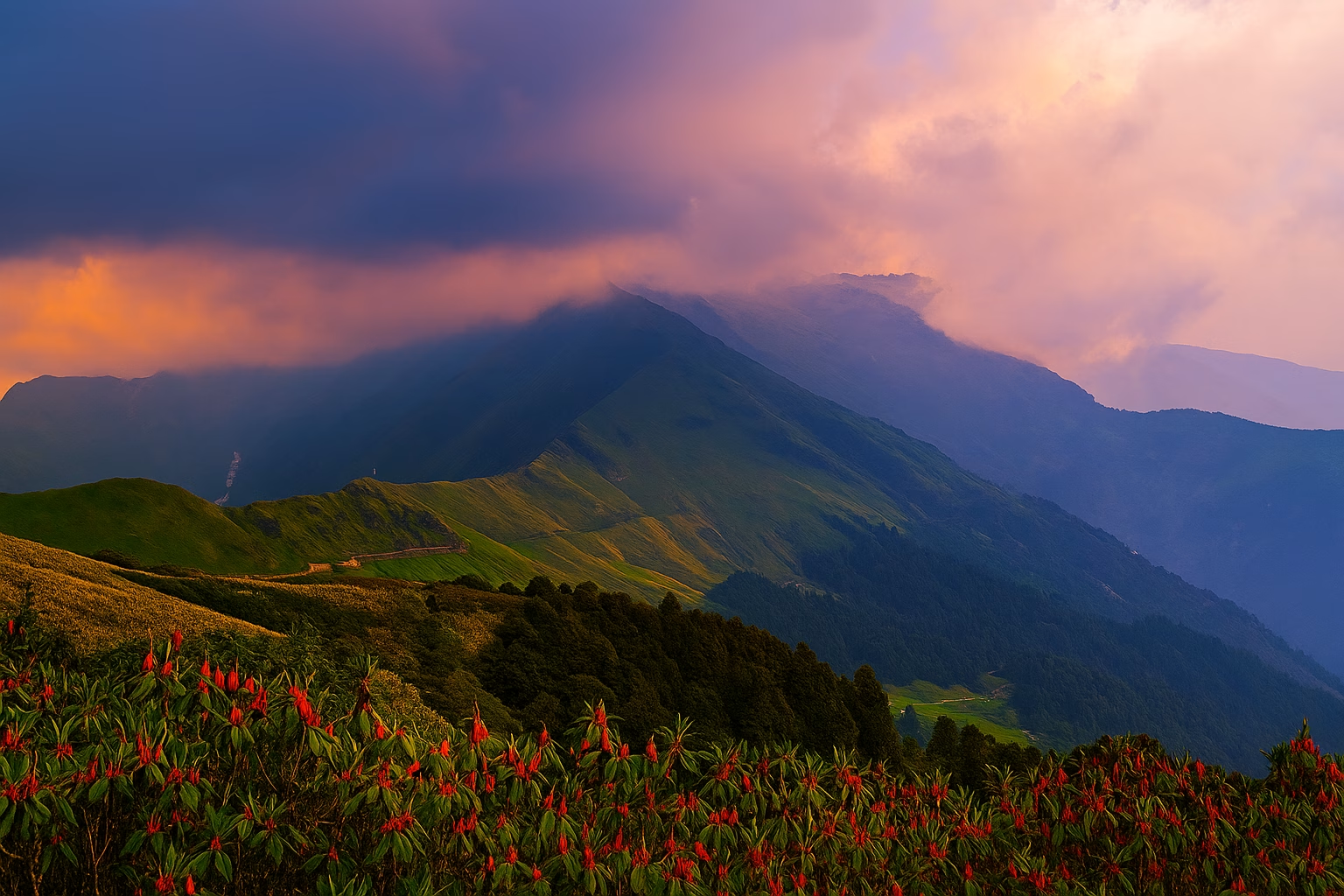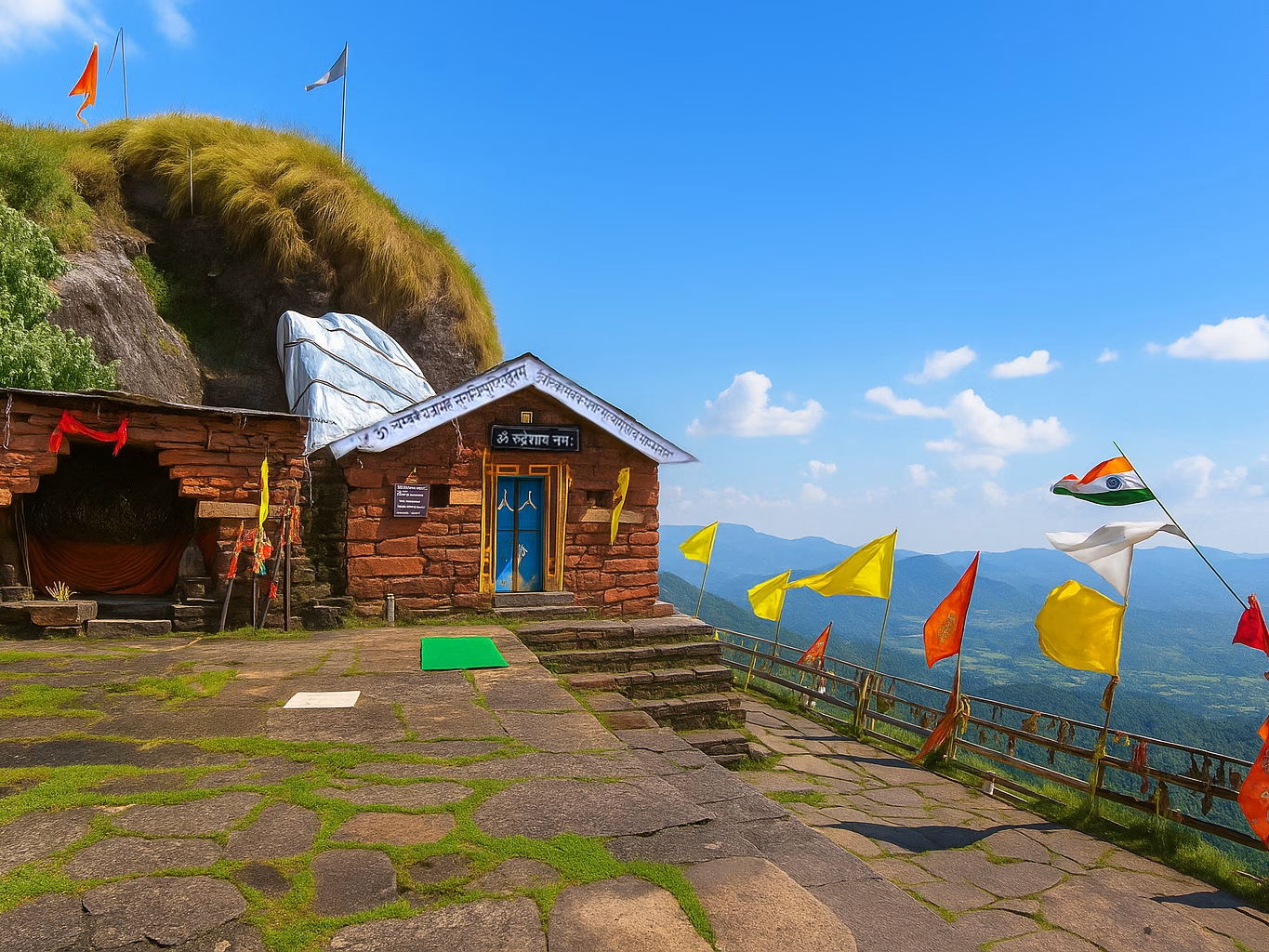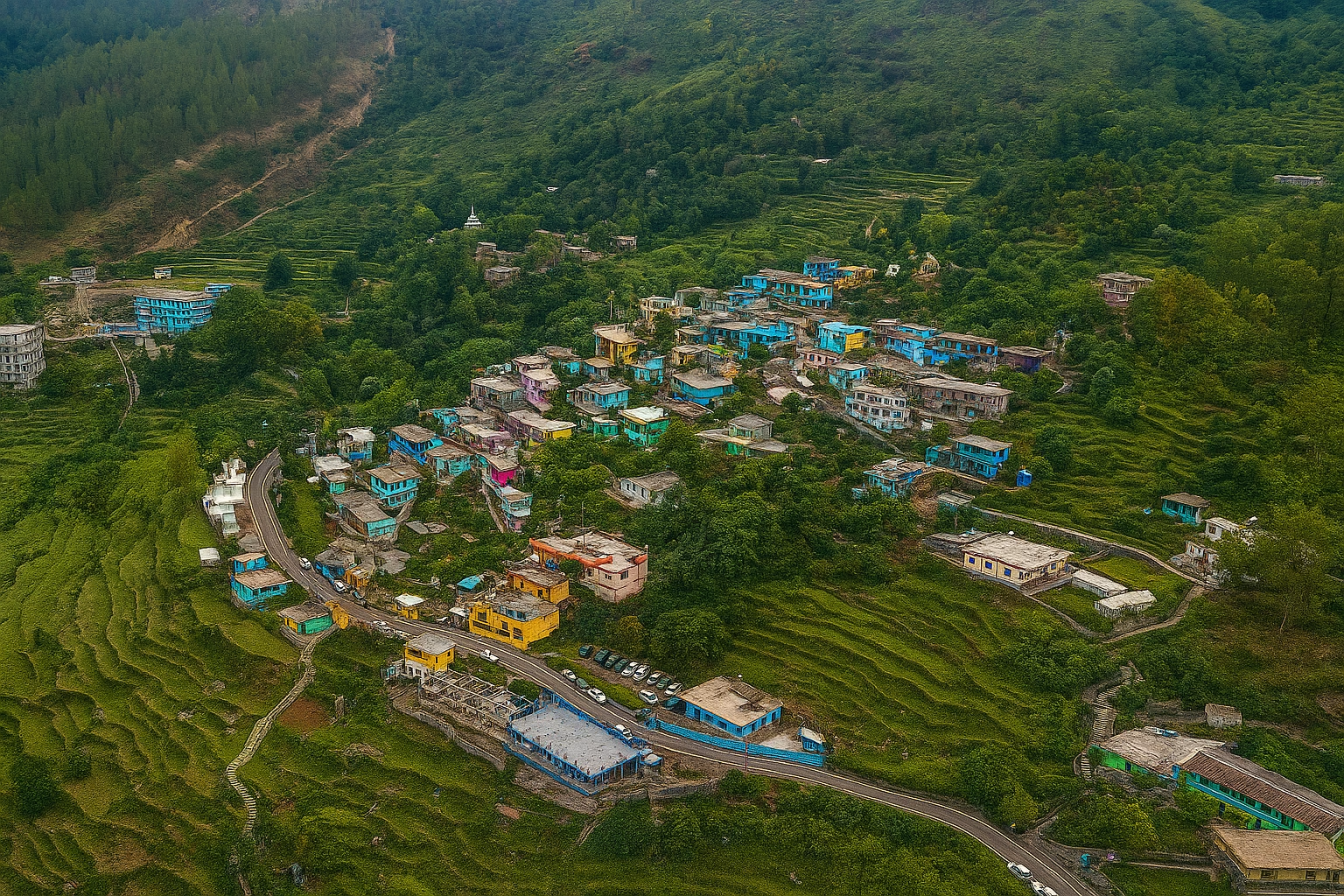5 Days 4 Nights
Daily Tour
50 people
___

Dist: 212 km | Time: 7 to 9 hrs | Altitude: 372 m to 1950 m
You will gather at the meeting point early morning in Rishikesh, from where you will drive towards Sagar village, covering approximately 212 km. In the evening, after arriving at Sagar Village, you will check into your Hotel and enjoy a peaceful overnight stay amidst scenic landscapes.
Meals: Dinner
Night: Stay at the hotel in Sagar Village

Trek Dist: 9.5 km | Altitude: 1950 m to 3000 m
Today, after breakfast, you will start your trek crossing Pung Bugyal. After which, you will go for a steep climb through dense forests, leading you to the beautiful landscape of Lyuti Bugyal, where you will stay in the tents for the night.
Meals: Breakfast, Dinner
Night: Stay in the tents at Lyuti Bugya

Trek Dist: 12.5 km | Altitude: 3000 m to 3600 m
Today will be a little challenging as you will cover around 12 km in one day. You will start the trek towards Rudranath Temple early in the morning, before 7:00 am. In the evening, you will arrive at Rudranath Temple, where you will enjoy welcome tea at the campsite and then visit Saraswati Kund. You can also attend the aarti of Rudranath Mahadev at 6:00 pm. After the dinner, you will stay in your camps
Meals: Breakfast, Dinner
Night: Stay in the tents at Rudranath

Trek Dist: 22 km | Altitude: 3600 m to 1950 m
After waking up to the view of Rudranath today, you will descend to Sagar Village. The downhill trek will be a little bit challenging, as you have to descend 22 km in one day. You have to start early at 7:00 am to reach Sagar at around 7:00 pm. After reaching Sagar village in the evening, you will check into your hotel, enjoy dinner and take rest.
Meals: Breakfast, Dinner
Night: Stay in the tents at Rudranath

Dist: 212 km | Time: 7 to 9 hrs | Altitude: 1950 m to 372 m
At 6:00 am, you will drive towards Urgam Village and take a short walk of 500 metres to reach Kapleshwar Temple. After visiting the Temple, you will depart for Rishikesh. After a journey of 212 km, you will be dropped at Rishikesh late in the evening, after which you can stay at Rishikesh(excluded) or continue your journey home.
Meals: Breakfast
Night: Nil
Note: This is just an explanation of medication that may be required. Kindly consult your doctor for a prescription before trekking.
We understand that plans can change, but please note that the booking amount is non-refundable due to the costs we incur in preparing for your tour or activity. If you wish to reschedule for a different date, we'll adjust it to the same package, providing you with the necessary flexibility. If you have paid the total amount but cancelled the package. You will be provided with a refund, as mentioned below:
Tours or activities may be cancelled due to unforeseen events beyond our control, such as severe weather conditions or government restrictions, including sudden closures of specific areas. In such a scenario, we will provide an alternate tour or activity. However, no refunds will be provided.
Forget every trek you’ve ever done. The Rudranath Trek is different. This isn’t a casual hike to a scenic viewpoint. It’s a rigorous, five-day pilgrimage that tests your physical limits and spiritual resolve. Located in the remote Sagar Village of Uttarakhand, this trek takes you to 3600 m, where the self-manifested stone mukha (face) of Lord Shiva is worshipped within an ancient temple.
At 22 kilometres, it may not sound like the longest trek, but it’s one of the most demanding of the Panch Kedar (Five Shivas). This is not a journey you do by accident. It’s a conscious choice to step away from the crowded trails and engage with something raw, powerful, and deeply transformative.
This is not just another mountain experience; it is a life-changing pilgrimage. If you’re looking for a leisurely walk, this isn’t it. But if you’re ready to test your limits and connect with a tradition centuries old, Rudranath is waiting.
Before you pack your bags, let’s be clear. The Rudranath trek separates casual hikers from committed mountain travellers.
This trek is for you if:
You should reconsider this trek if:
The Start: Sagar Village (5,100 ft): This traditional Garhwali village is your last brush with modern convenience. Take a breath, acclimatise, and prepare. Once you leave Sagar, you are reliant on your fitness, your guide, and your willpower.
The Meadows: Pung Bugyal & Lyuti Bugyal (7,800 ft – 9,800 ft): The first leg takes you through a dense forest. After a couple of hours, the canopy breaks, and you enter Pung Bugyal, a stunning high-altitude meadow. Here, a local dhaba serves simple, hot meals—your last easy comfort. The trail continues its steep ascent to Lyuti Bugyal, your likely first campsite. The views of the surrounding peaks are a stark reminder that you are now in the “abode of the gods.”
The Vista: Panar Bugyal (11,000 ft): This is one of the trek’s main highlights. Panar is an enormous, rolling meadow that offers your first truly unobstructed, mind-blowing views of the Nanda Devi and Trishul massifs. You’ll spend crucial time here acclimatising, which is essential before the final push to the temple.
The Test: Pitradhar Ridge: This part of the trek is steeped in mythology, known as the path for the souls of ancestors. It will test your nerve and balance. The trail narrows significantly, with dramatic, heart-stopping drop-offs on both sides of the gorge. This is where your focus is paramount.
The Destination: Rudranath Temple (11,800 ft): After navigating the ridge, you arrive. The ancient stone temple, set against a backdrop of rock and sky, is overwhelming. Here, you’ll find the sacred swayambhu (self-manifested) face of Lord Shiva. Participating in the evening aarti (6:00 PM) and morning aarti (8:00 AM) is an experience of profound, enveloping spirituality that stills the mind.
The Natural World: Forests & Wildlife: The route winds through pristine, dense forests of rhododendron, oak, and pine. This is the heart of the Kedarnath Wildlife Sanctuary. While the elusive snow leopard is rarely seen, you may spot its tracks. Keep your eyes peeled for Himalayan tahr (mountain goat), musk deer, and the vibrant call of the Himalayan Monal.
Do not underestimate this trek. There’s a local Garhwali saying: “रुद्रनाथ की चढ़ाई और जर्मन की लड़ाई” (Rudranath’s climb is like fighting a war with the Germans). This highlights the legitimate physical and mental stress you’ll endure.
Start training 4 to 5 weeks before your trek.
Cardiovascular Endurance (Stamina): Be able to run 5 to 7 km in 30 to 40 minutes. You can practice Jogging, cycling, swimming, or climbing stairs, 4 to 5 days a week.
Strength Training (Legs & Core): Build power for the endless uphill sections. Focus on squats, lunges, step-ups, and planks.
Practice Hikes (The Most Important): On weekends, find a local trail or hill and hike for 4-5 hours carrying a 5 to10 kg backpack. This trains your muscles, breaks in your boots, and prepares you mentally.
The temple is only open for six months. Your trek’s success and safety depend entirely on the season.
You are entering the Kedarnath Wildlife Sanctuary, and permits are mandatory. Failure to obtain one can result in penalties under the Wildlife Protection Act, 1972.
Required Documents: A valid photo ID (Aadhaar, Passport, or Driver’s License) and your printed registration receipt (if done online).
While several paths exist, one is the most common and accessible.
The Panch Kedar is a pilgrimage of five sacred Shiva temples in the Garhwal Himalayas. According to legend, they are the bodily forms of Shiva. They are: Kedarnath (hump), Tungnath (arms), Rudranath (face), Madhyamaheshwar (navel), and Kalpeshwar (hair).
It is highly discouraged. The trail is remote, physically demanding, and has sections with steep exposure. Weather changes rapidly, and in case of an emergency (like altitude sickness or injury), you would be on your own. Always trek with a certified guide or in a small group.
Do not expect guesthouses. Accommodation is in tents (at campsites like Lyuti and Panar) or in very basic, shared rooms at the temple dharmashala, which is often just a stone hut.
No. You may get a weak signal at Sagar village, but as soon as you start the trek, you will have no mobile network or internet access until you return.
Leave a review